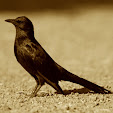Mention Mokala National Park to many people and you're likely to get a bit of a blank stare. As South Africa's newest national park, it is little known, and because it doesn't have some of the usual charismatic megafauna (read 'lions') people tend to overlook it.
 |
| Haak-en-Steek, Mokala National Park |
Well, for me, all that changed when my mother said she'd like to visit. We stayed at the Haak-en-Steek cottage. You know that you've stumbled onto something good when you immediately book to go back upon your return home.
 |
Sunset at Haak-en-Steek
|
Mokala lies about 70km south-southwest of Kimberley and its name means 'camelthorn tree' in Setswana. This is the park's signature tree but the area offers a variety of landscapes, from the red sands of the Kalahari to the dolorite hills of the Karoo (which are said to have many significant rock engravings) and the grassy plains more characteristic of the Free State.
The park is a bit of Noah's Ark as it's also used as a haven for rare antelope species such as tsessebe, roan and sable. They have disease-free buffalo, rhino and a quagga breeding programme (to bring back the zebras with the white bottoms).
The Haak-en-Steek cottage was once the weekend hideaway of the former owner of what was once a game farm in the 'Kalahari' section of the park. If you check in here, you have it all to yourself, and there is a waterhole not much more than 100m away from the stoep.
From this stoep, we could sit and watch the passing parade, which consisted of a variety of game: eland, springbok, gemsbok, hartebeest, tsessebe, kudu, wildebeest, warthogs, vervet monkeys, ostrich, even impala... The warthogs and ostriches tended to visit during the daylight hours and the vervets would chill around the dam in the middle of the day. The shyer kudu and some of the other game tended to come at dusk and dawn. The main bedroom has a huge sliding door that looks directly out onto the dam.
 |
| Warthogs to the left, impala to the right... |
 |
| Eland at the waterhole |
The trees around the cottage were also home to a wonderful variety of birds, including a very vocal scimitarbill looking for a mate. I'm happy to report he found one (see image below). We also heard and saw the dideric cuckoo, an African hoopoe, a nesting golden-tailed woodpecker, swallow-tailed bee-eaters, golden buntings and many more...
 |
| Scimitarbill courtship |
Our visit coincided with a rather severe drought that is gripping the western, more arid parts of South Africa and so we had a rather poignant sighting of a herd of buffalo trying to slake their thirst in the Stofdam (meaning 'dust dam'). They were so thirsty that they bellowed and started to run when they got close to the dam, but they had to wade into knee-deep mud to access the little puddles of water. We felt rather sorry for them.
 |
| The front runners break into a trot as they approach the dam |
 |
| Buffalo braving the mud |
There was weather brewing, though, which was a good sign. The first night we had a tremendous electrical storm with some fierce thunder and lightning (which my mother swears struck the ground on the far side of the waterhole). I was doing extreme braaiing, dashing in and out between thunderclaps to turn the chops on the coals. Sadly, for all its noise, this storm did not produce much rain.
 |
| Weather coming |
The next afternoon, matters looked up when another, deeper storm blew in around 3pm and delivered a few hours of soaking rain which created some temporary puddles, much to the joy of the birds. We spent the afternoon sitting in the lounge as we watched the downpour, and appreciated the moment.
 |
| Rain storm at Haak-en-Steek |
But at Stofdam, which we checked on the next day, this storm too had barely made a dent on the rapidly drying earth and the puddles of the day before dried up within a day. Mokala's drought is ongoing...
Travel tip
It's probably best to go in a high-clearance vehicle like a bakkie because the roads are not in tip-top condition and the 25km access road from the N12 to Mosu was particularly corrugated.
If you are self-catering, stock up before you enter the park as they don't really have a proper shop nor is there any fuel available. You can, however, buy the bare essentials (like matches and Blitz). For those travelling from Gauteng to the Cape, Mokala is an alternative stop off to the Karoo National Park, although somewhat off the national road
Mokala also has a good campsite called Motswedi (where each camping party has its own ablution block and kitchen) and a range of other accommodation. We had a brief look at the main camp (Mosu) and decided that the chalets were a bit on top of each other. Due to heavy rains and mud, we didn't make it to Lilydale which is on top of a hillside overlooking the Riet River.
 |
| Sundowners at Haak-en-Steek |












It looks lovely! We must make a plan to visit.
ReplyDeleteIt is delightful.
ReplyDeleteA peaceful place to live in.
ReplyDeletemeet and greet heathrow
airport parking stansted
Nice post thanks for shaaring
ReplyDelete